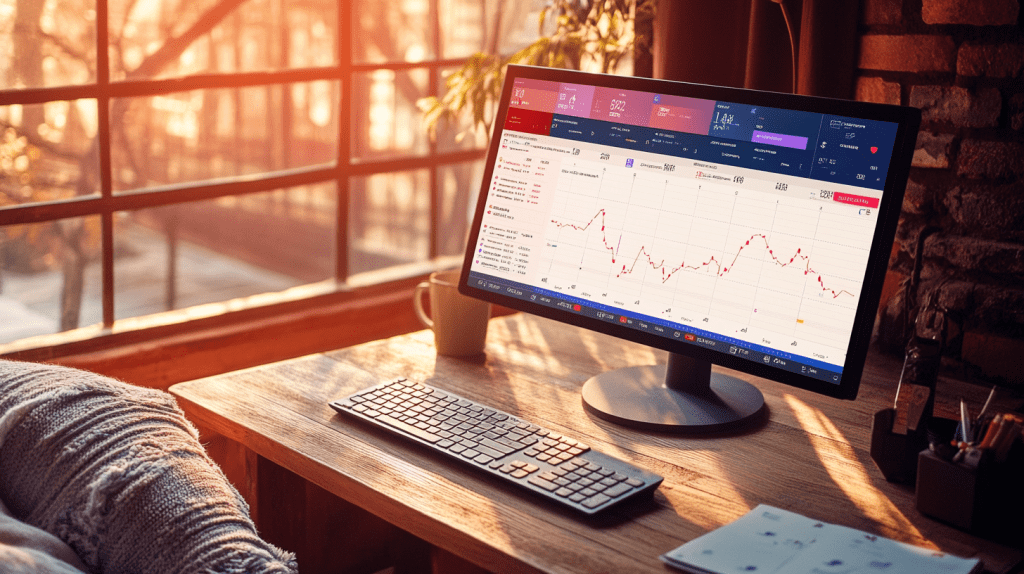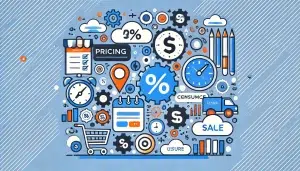
Table of Contents
- What Is Competitor Price History
- Decoding the Price Time Machine
- The Golden Nuggets: Benefits That’ll Make You Rich
- Tools of the Trade: Your Price History Arsenal
- From Data to Dollars: Turning Insights into Profits
- Myth Busters: Debunking Price History Hogwash
- My Dance with Data: A Personal Price History Tale
- Crystal Ball Gazing: Future Trends in Price History Analysis
- Ninja Moves: Pro Hacks for Price History Mastery
- Oops! Common Pitfalls to Sidestep
- The Price is Wrong: What Not to Do
- Wrapping Up: Your Price History Journey Begins
- FAQ
- Further Reading: Dive Deeper into Price History
What Is Competitor Price History
Competitor Price History refers to the tracking and analysis of changes in a competitor’s product prices over time.
By monitoring these fluctuations, businesses can gain insights into competitors’ pricing strategies, identify trends, and make informed decisions to optimize their own pricing.
This historical data helps companies anticipate market movements, react to competitors’ price changes promptly, and maintain a competitive edge in the market.
Decoding the Price Time Machine

Ever wished you had a crystal ball to peer into your competitors’ pricing strategies? Well, buckle up, e-commerce entrepreneurs, because competitor price history analysis is the next best thing! 🔮
Competitor price history is like the Sherlock Holmes of e-commerce—it uncovers the mysteries of your rivals’ pricing strategies over time. By tracking and analyzing past prices of products, you can identify trends, anticipate market shifts, and make data-driven decisions that’ll have your competition scratching their heads.
But here’s the million-dollar question: How can understanding competitor price history transform your e-commerce business? Simple. It’s like having a cheat code for your pricing strategy, inventory management, and market positioning.
By leveraging historical pricing data, you can optimize your prices, boost your profit margins, and stay one step ahead of the competition. It’s not just about knowing what your competitors are charging now—it’s about understanding their pricing patterns and using that knowledge to your advantage.
Think of it as a time machine for your business. You’re not just seeing the present; you’re getting a glimpse of the past and using it to predict the future. It’s like being able to watch all seasons of “Game of Thrones” before making your move in the game of e-commerce thrones!
The Golden Nuggets: Benefits That’ll Make You Rich
Let’s dive into the treasure trove of benefits that competitor price history analysis can offer. It’s like finding a pot of gold at the end of a data rainbow!
Strategic Pricing Decisions:
- Make informed decisions that enhance competitiveness.
- Anticipate future price changes and adjust your strategies accordingly.
- Identify the best times for discounts and promotions.
Increased Profit Margins:
- Find the sweet spot between competitiveness and profitability.
- Avoid setting prices too low or too high.
- Capitalize on high-demand periods to boost your bottom line.
Market Trend Insights:
- Spot trends before they become obvious to everyone else.
- Be proactive rather than reactive in your pricing strategy.
- Guide your product development and inventory management.
Risk Mitigation:
- Learn from competitors’ pricing mistakes.
- Avoid overpricing or underpricing your products.
- Develop robust pricing strategies that stand the test of time.
According to a study by Forrester Research, companies that use price optimization software see an average profit increase of 11% in the first year alone. That’s not just pocket change—it’s a game-changer!
But here’s the kicker: only 22% of businesses consistently monitor their competitors’ prices, according to a recent survey. That means by diving into competitor price history analysis, you’re already ahead of 78% of the pack. Talk about a competitive advantage!
Tools of the Trade: Your Price History Arsenal

Now that you’re sold on the power of competitor price history, let’s talk about how to harness it. You wouldn’t go into battle without your weapons, right? Well, in the e-commerce world, your weapons are your tools.
Here’s your arsenal for competitor price history domination:
- Dashboard Analytics:
These are your command centers. They provide a bird’s-eye view of pricing trends, allowing you to spot patterns at a glance. Look for tools that offer customizable dashboards so you can focus on the metrics that matter most to your business. - Visualization Tools:
As they say, a picture is worth a thousand words—or in this case, a thousand data points. Graphs and charts can help you visualize price fluctuations over time, making it easier to identify trends and anomalies. - Automated Price Tracking Software:
Manual price tracking is so last century. Automated tools can monitor your competitors’ prices 24/7, alerting you to changes in real-time. It’s like having a tireless price-watching robot on your team!. Pricefy is probably the best candidate, try it today, is free! - Historical Price Databases:
These are the time machines of the pricing world. They store vast amounts of historical pricing data, allowing you to look back months or even years to identify long-term trends. - Competitive Intelligence Platforms:
These comprehensive tools often combine several features, offering price tracking, market analysis, and even predictive analytics all in one package.
Remember, the goal isn’t just to collect data—it’s to turn that data into actionable insights. Choose tools that not only gather information but also help you analyze and apply it.
Pro Tip: Many of these tools offer free trials. Take advantage of these to test-drive different options and find the one that best fits your needs and budget.
From Data to Dollars: Turning Insights into Profits
Alright, you’ve got your tools, you’ve collected your data—now what? It’s time to turn those insights into cold, hard cash. Here’s how to apply your newfound knowledge of competitor price history:
- Dynamic Pricing Strategies:
Use historical data to implement dynamic pricing. If you know your competitor always drops prices on Tuesdays, you could beat them to the punch by lowering yours on Monday. It’s like playing chess, but with prices! - Smarter Inventory Management:
Historical pricing data can help you predict demand. If prices for a product have been steadily rising over the past few months, it might be time to stock up before they go even higher. - Strategic Sales and Promotions:
Plan your sales around your competitors’ historical pricing patterns. If you notice they always have a big sale in July, you could run yours in June to capture the market first. - Product Development:
Use pricing trends to inform your product development. If you see prices for a certain type of product consistently rising, it might be time to develop your own version to capture some of that market. - Competitive Positioning:
Understanding long-term pricing trends can help you position your products more effectively. Are you consistently priced higher than competitors? Maybe it’s time to focus on premium branding to justify that price point.
Remember, the goal isn’t always to have the lowest price. Sometimes, the data might show that you can actually raise prices without losing customers. It’s all about finding that sweet spot where profitability meets competitiveness.
And here’s a juicy tidbit: according to a McKinsey study, a 1% price increase translates to an 8.7% increase in operating profits, assuming no loss of volume. That’s the power of smart pricing!
Myth Busters: Debunking Price History Hogwash
Let’s clear the air and bust some myths about competitor price history analysis. It’s time to separate fact from fiction!
Myth 1: It’s all about having the lowest price
Reality: Price history analysis isn’t about racing to the bottom. It’s about understanding market dynamics and finding the optimal price point. Sometimes, the data might show that a higher price actually increases perceived value and sales!
Myth 2: Historical data is always relevant
Reality: While historical data is valuable, it’s not always predictive. Market conditions change, new competitors emerge, and consumer preferences shift. Always consider current market context alongside historical trends.
Myth 3: More data is always better
Reality: Quality trumps quantity. Focus on collecting relevant, accurate data rather than drowning in a sea of numbers. It’s better to have insightful data on your top competitors than superficial data on every business in your industry.
Myth 4: Price history analysis is only for big businesses
Reality: Thanks to modern tools and software, businesses of all sizes can leverage price history analysis. You don’t need a massive budget or a team of data scientists to get started.
Myth 5: Once you set up price tracking, you can set it and forget it
Reality: Effective price history analysis requires ongoing attention and adjustment. Markets evolve, and so should your approach to analyzing them.
Remember, in the world of e-commerce, knowledge is power. Don’t let these myths hold you back from harnessing the full potential of competitor price history analysis!
My Dance with Data: A Personal Price History Tale

Let me tell you a story about my own adventure with competitor price history analysis. Picture this: it’s 2019, and I’m running my small online electronics store, barely keeping my head above water in a sea of fierce competition.
One day, while drowning my sorrows in a tub of ice cream (mint chocolate chip, if you must know), I stumbled upon an article about price history analysis. Intrigued, I decided to give it a shot. What did I have to lose, right?
I started small, tracking just five of my top-selling products and their prices across three major competitors. At first, it felt like I was drowning in numbers. But slowly, patterns started to emerge. I noticed that one competitor always dropped their prices on Thursdays, while another had a habit of raising prices just before major holiday.
Armed with this knowledge, I started adjusting my pricing strategy. I’d lower my prices on Wednesdays, capturing those price-sensitive customers before my competitor’s Thursday drop. And I’d stock up on inventory just before the holidays, allowing me to maintain competitive prices while others were raising theirs.
The results? In just six months, my revenue increased by 23%, and my profit margins improved by 15%. It wasn’t magic—it was the power of data.
Now, I won’t pretend it was all smooth sailing. There were plenty of missteps along the way. Like the time I got so caught up in matching a competitor’s price drop that I didn’t realize they’d made a pricing error. Oops! But each mistake was a learning opportunity, refining my approach and making my strategy stronger.
The moral of the story? Don’t be afraid to dip your toes into the world of competitor price history analysis. Start small, learn as you go, and before you know it, you’ll be dancing with data like a pro!
Crystal Ball Gazing: Future Trends in Price History Analysis
Hold onto your hats, folks, because the future of competitor price history analysis is looking mighty exciting! Let’s peer into our crystal ball and see what’s coming down the pike.
- AI-Powered Predictive Pricing:
Artificial Intelligence is set to revolutionize how we analyze and apply price history data. Imagine algorithms that can predict your competitors’ pricing moves before they make them. It’s like having a psychic on your pricing team! - Real-Time, Automated Adjustments:
As technology advances, we’re moving towards systems that can analyze competitor price history and make instantaneous pricing adjustments. It’s like having a Formula 1 pit crew for your prices, making split-second tweaks for optimal performance. - Integration with Other Data Sources:
The future will see price history analysis combined with other data sources like social media sentiment, weather patterns, and economic indicators for a more holistic view of the market. - Blockchain for Price Transparency:
Blockchain technology could create tamper-proof records of historical pricing data, increasing transparency and trust in the e-commerce ecosystem. - Personalized Pricing Strategies:
With advancements in data analysis, we’ll see more granular, personalized pricing strategies based not just on competitor prices, but on individual customer behavior and price sensitivity.
According to a report by MarketsandMarkets, the price optimization and management market is expected to grow from $17.5 billion in 2019 to $37.5 billion by 2024. That’s a compound annual growth rate of 16.9%! Clearly, the future of price history analysis is not just bright—it’s dazzling.
But remember, with great power comes great responsibility. As these technologies evolve, it’ll be crucial to use them ethically and in ways that benefit both businesses and consumers.
The future of pricing is smart, dynamic, and customer-centric. Are you ready for it?
Ninja Moves: Pro Hacks for Price History Mastery

Ready to take your competitor price history analysis to the next level? Here are some pro tips that’ll turn you into a pricing ninja:
- The Seasonal Shuffle: Use historical data to identify seasonal pricing patterns. Then, strategically adjust your prices just before the season hits. It’s like surfing—catch the wave before it crests!
- The Loss Leader Lookout: Keep an eye on competitors’ loss leaders (products sold at a loss to attract customers). Historical data can help you identify these patterns and plan your own promotions accordingly.
- The Bundle Bonanza: Use price history to identify products that are frequently discounted. Consider bundling these with higher-margin items for attractive deals that maintain profitability.
- The Nightowl Nudge: Many retailers adjust prices at night. Set up alerts for these changes and be ready to react first thing in the morning.
- The Margin Maintainer: Set up automatic alerts for when competitor price changes threaten your profit margins. This allows you to quickly decide whether to match the price or differentiate in other ways.
Remember, these tricks aren’t about blindly reacting to every competitor move. They’re about using historical data to anticipate changes and make strategic decisions. It’s not about working harder—it’s about working smarter!
Oops! Common Pitfalls to Sidestep
Even pricing pros can stumble. Here are some common pitfalls to avoid in your competitor price history analysis journey:
- Data Overload: Don’t try to track everything. Focus on your key products and most important competitors. Quality over quantity!
- Ignoring Context: Price changes don’t happen in a vacuum. Always consider factors like holidays, events, or supply chain issues when analyzing price history.
- Reactionary Pricing: Don’t fall into the trap of always matching competitor prices. Sometimes, holding steady is the best strategy.
- Neglecting Your Costs: Never let competitor prices drive you below your profitability threshold. Your price history analysis should always factor in your costs.
- Forgetting the Customer: In the midst of all this data, don’t lose sight of your target customer and what they value. The lowest price isn’t always the winning strategy.
By steering clear of these pitfalls, you’ll be well on your way to pricing success!
The Price is Wrong: What Not to Do
Now that we’ve covered the dos, let’s talk about the don’ts. Here are some pricing faux pas to avoid:
- Don’t Ignore Your Data: If you’ve invested in tools to track competitor price history, use the insights! Don’t let valuable data gather dust.
- Don’t Price in a Bubble: Your prices don’t exist in isolation. Always consider your overall market positioning and brand value.
- Don’t Obsess Over Competitors: While competitor price history is valuable, don’t let it dictate your entire strategy. You’re running your business, not theirs.
- Don’t Forget to Test: Historical data is great, but don’t be afraid to try new pricing strategies. Just do it in a controlled, measurable way.
- Don’t Neglect Your Uniqueness: If you have unique selling points, don’t undervalue them in an attempt to match competitor prices.
Remember, pricing is as much an art as it is a science. Use your competitor price history data as a guide, not a rulebook.
Wrapping Up: Your Price History Journey Begins
And there you have it, folks—your comprehensive guide to unlocking profitable insights with competitor price history analysis. From understanding the basics to implementing pro-level strategies, you’re now equipped to turn pricing data into your secret weapon.
Remember, the e-commerce landscape is always evolving, and so should your pricing strategy. Competitor price history analysis isn’t a one-and-done task—it’s an ongoing journey of learning, adapting, and optimizing.
So, what are you waiting for? Dive into that data, uncover those trends, and start making pricing decisions that’ll have your competitors wondering what hit them. Your path to e-commerce success is paved with smart, data-driven pricing strategies.
Now go forth and conquer, you pricing guru, you!
FAQ: Your Burning Questions Answered
Q: How often should I analyze competitor price history?
A: Ideally, you should be monitoring competitor prices continuously, but analyze the data at least weekly. For fast-moving markets, daily analysis might be necessary.
Q: Can I do competitor price history analysis manually?
A: While it’s possible for a very small number of products, it’s time-consuming and prone to errors. Using automated tools is much more efficient and accurate.
Q: How far back should I look when analyzing price history?
A: It depends on your industry, but generally, looking back at least a year can help you identify seasonal trends. For some products, even longer historical data can be valuable.
Q: Is it legal to track competitor prices?
A: Yes, as long as you’re using publicly available information. Just ensure you’re not using any unethical methods to gather this data.
Q: How do I choose which competitors to track?
A: Focus on your direct competitors and market leaders in your niche. Quality of data is more important than quantity.
Further Reading: Dive Deeper into Price History
“Pricing Strategy: Set the Right Price for Every Product” by Tim J. Smith
“Competing on Analytics: The New Science of Winning” by Thomas H. Davenport
“The Art of Pricing” by Rafi Mohammed




